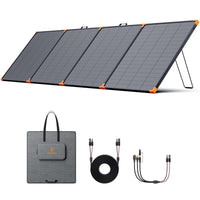Most Efficient Solar Panels in 2025: Latest Technology & Buying Guide
Solar panel efficiency has improved dramatically in recent years, making solar energy more practical and cost-effective than ever. If you're looking for the most efficient solar panels in 2025, you're in the right place.Let’s dive in!

🔹 What Are the Most Efficient Solar Panels in 2025?
The efficiency of a solar panel refers to how much sunlight it can convert into usable electricity. The higher the efficiency, the more power it generates in a given space.
Here are the top-performing solar panels in 2025 based on recent breakthroughs:
|
Technology |
Efficiency Rating |
Manufacturer |
|
HJT (Heterojunction) Solar Cells |
25.44% |
Trina Solar (China) |
|
TOPCon (Tunnel Oxide Passivated Contact) |
27.08% |
Multiple manufacturers |
|
Perovskite-Silicon Tandem Cells |
28.6% |
Qcells (South Korea) |
🔹 HJT solar panels combine crystalline silicon and thin-film layers, delivering high efficiency and excellent temperature resistance.
🔹 TOPCon solar cells improve electron flow, achieving over 27% efficiency.
🔹 Perovskite-Silicon tandem cells are pushing efficiency beyond 28%, though commercial adoption is still in progress.
Why does efficiency matter? The higher the efficiency, the fewer panels you need to generate the same amount of power, which is especially useful for homes with limited roof space or RV owners looking for maximum output.
Key Solar Technology Trends in 2025
1️、Perovskite Solar Cells Are Going Commercial
Japan has invested $1.5 billion to develop ultra-thin perovskite solar cells, which are lightweight, flexible, and incredibly efficient. These could revolutionize the industry, making solar panels more accessible for rooftops, vehicles, and even clothing.
(Source: Financial Times)
2️、Bifacial Solar Panels Are Becoming the Norm
Bifacial solar panels absorb sunlight from both sides, increasing total energy output. They’re widely used in commercial installations and are now gaining popularity for residential and RV applications.
3️、Smart Solar Systems with AI Integration
Artificial intelligence (AI) is being used to optimize solar energy production, adjust panel angles throughout the day, and predict weather patterns for better energy management.
How Efficiency Impacts Real-World Applications
High-efficiency panels can significantly impact:
✅ Home Installations – More power in less space, ideal for small rooftops.
✅ RV & Camping – Lightweight, high-output panels reduce reliance on generators.
✅ Off-Grid Living – Maximizes energy production where every watt counts.
✅ Long-Term Savings – More power generation means lower electricity bills and a faster return on investment.
How to Choose the Best High-Efficiency Solar Panels
When selecting a solar panel, consider the following:
1️、Efficiency vs. Cost
High-efficiency panels often come at a premium price. If space is limited, the extra cost may be worth it. If you have plenty of room, slightly lower efficiency panels can save you money.
2️、Durability & Warranty
Look for panels with a 25-year performance warranty and low degradation rates (meaning they’ll still produce over 80% of their original output after 25 years).
3️、Application-Specific Needs
- Homeowners → Look for HJT or TOPCon panels for maximum efficiency.
- RV Owners → Choose lightweight, high-output foldable panels for easy setup.
- Off-Grid Users → Consider bifacial or perovskite panels for increased power generation.
Future Outlook: What’s Next for Solar Panels?
🌞 Perovskite-silicon hybrid panels may become the new standard, offering 30%+ efficiency.
🌞 Solar panel recycling programs will expand as older panels reach the end of their lifespan.
🌞 Integrated solar roofing (like Tesla’s solar roof) will become more affordable and widespread.
Are Less than 25% Efficiency Solar Panels Still Worth Buying?
Yes, solar panels with Less than 25% efficiency are still an excellent investment, even as newer technologies emerge. While cutting-edge panels like perovskite-silicon tandem cells are achieving 28%+ efficiency, they are still in early stages of commercialization, meaning higher costs and limited availability.
Here’s why Less than 25% efficiency panels remain a top choice in 2025:
✅ Proven Technology – High-efficiency monocrystalline N-Type panels (such as HJT and TOPCon) are widely available, durable, and already optimized for real-world performance.
✅ Great Performance in Limited Space – If your roof or RV has limited space, a Less than 25% efficiency panel produces more power per square foot than lower-efficiency options.
✅ Cost-Effectiveness – The price per watt for these panels is more affordable than experimental 28%+ efficiency models, which are still premium-priced.
✅ Long-Term Reliability – Many N-Type panels have low degradation rates, retaining 85%+ output after 25 years.
Final Thoughts: Are High-Efficiency Solar Panels Worth It?
High-efficiency solar panels are a smart investment for anyone looking to maximize energy output, save space, and reduce long-term costs.
With technologies like HJT, TOPCon, and perovskite-silicon tandem cells leading the way, solar power is becoming more efficient, accessible, and cost-effective than ever.
Looking for the best high-efficiency solar panels? Explore ZOUPW’s latest N-Type solar solutions today! ☀️🔋
Share

